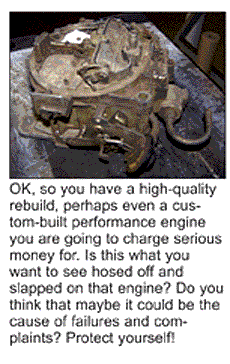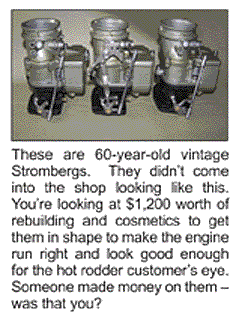Recently I’ve been inside a few carbs. I found myself first forgetting that things have changed and then developing a real nostalgia for the old days when this was a lot less difficult.
If you still have any small thought that slapping a quick kit into an old carb will be the end of it, you are deep in denial. For that matter, if you think that you can grab a new carb off the shelf and make it work right, you are equally uninformed.
This is important in that when you build that carbureted engine, either you or your customer will have to face the harsh reality that things have changed. If not, you could be plagued with complaints about poor running, poor performance or even damage resulting from improper mixture or functions. Even if you never touch a carb yourself, you need to be aware of the situation, know what to do, or advise your customer what to do, and protect yourself along with your shop reputation. You know I’m right, and you’ve probably already found some character trashing your reputation and threatening legal action because HIS carb ended up damaging YOUR workmanship.
While there’s certainly nowhere near the volumes required to fully cover this now, we can at least be aware of the principle issues that can trip you or your customer up and that will prevent most of your troubles.
If you change the engine, you will likely have to change the carb. More cam, more cubes, improved flow from heads or manifolds, dual exhaust instead of single, and others will all change the performance level and therefore potentially mean you have to replace or recalibrate the carb. It just takes more fuel to make more power – right?
Carbs wear out. There’s probably no better example than the QuadraJet. A fine carb, thoroughly adjustable, efficient and durable, it has two consistent problems. One is that the primary throttle bores wear out and need to be re-bushed. Fail to and you get vacuum leaks, lean mixtures, poor running and, potentially, mechanical damage. The other is leaks from the fuel bowl body plugs. These need to be prepped and epoxyed or they never stop. If someone doesn’t fix the carb so it functions as it was designed, you are risking an unhappy customer.
New carbs are not calibrated for your specific engine. They are roughly calibrated, so over a wide range they will be close enough to run the engine and get you to a starting point. As a policy, carb makers will jet the carbs so they are over-rich (prevents lean-out damage and angry customers with lawyers) and generally the secondaries come in late. When we dyno an engine, the carb is first checked and calibrated, because unless it is functioning right we can’t get peak performance, or worse – a valve or piston could end up fried. If you make sure your customer understands this and is prepared to make the needed changes, it is no longer your responsibility and you’ve done them an honest turn.

Fuels have changed. Modern fuels are no longer designed for carbs, but for EFI. It makes a big difference. The most important change I know of is the lowering of the evaporation point. Simply put, fuel now has a lower boiling point than it used to. This results in float bowls drying out and harder starting. It causes accelerator pumps to fail when the fuel and additives and wet/dry cycles destroy the pump cups. It causes vapor locking, overheating and detonation from lean mixtures. You may be surprised to learn that the engine you are building FAILED because of these things and now you are going to put the same accessory parts and carb on without curing the problems! You should be able to see what’s coming.
Alcohol. There’s a big push to add alcohol to fuels. We all know the reasons that this is happening and, frankly, I’m not going to debate it one way or the other. What I do know is that alcohol changes mixtures in carbureted engines. It takes almost twice as much alcohol as gasoline to produce the same amount of power. That means that to feed your engine, if alcohol is added, it will require more fuel and a richer mixture. You either have to de-tune the engine or re-jet the carb. Sometimes jets, siphon tubes, internal passage sizes, power valves, and more need attention. If you send out an engine that already runs lean and the carb is not recalibrated to accommodate alcohol fuels, you could end up with performance complaints or damaged internal components.
EFI works differently because these systems look for proper mixtures by sniffing the exhaust and listening for knock and sensing heat. Carbs can’t and don’t make adjustments like EFI does. In my daily driver, if I use straight non-alcohol regular I can get 20 MPG all day long. If I put the alcohol fuel in the tank this drops down to between 14 and 16 mpg. A 10-20 percent drop in fuel mileage is not uncommon. However, EFI will accommodate this change in fuel quality and simply add more fuel to normalize conditions. With a carb you just cause running problems and engine damage if you don’t recalibrate
Over-carburetion. We still suffer from “bigger is always better” syndrome. I don’t know how many times I have to say this, but it’s NOT. Too often people will take their fresh new engine, slap it into the hole, and then add about twice what the engine can ever hope to use for carburetion. They think they are improving performance, but usually they are making problems. Too much carb will cause hesitation, stumbling, decreased performance, poor fuel mileage, and lots of disappointment.

On the WebRodder.com Web site in the Forum, you will see a section with calculators (this is a free site). Plug in the engine data and you’ll get a cfm capacity for that engine. It will surprise you when you find out just how often people use way more carb than the engine can handle! For example, a 350 cube engine, with a red-line of 6,500 rpm and operating at 100 percent volumetric efficiency (few engines do this) needs just 658 cfm. Throwing that 850 cfm unit on this engine will kill performance where it can be used for the sake of theoretical performance above where the engine will ever be run. Am I the only one who sees how dumb that is?
The bottom line here is that you can do a perfect, high-quality job in your shop and send out an engine that should run well and long only to find that because the carb wasn’t rebuilt, repaired, recalibrated, or simply the wrong one you see it come back with failures and complaints. I’m suggesting that at the very least you educate yourself and your customer to prevent this.
Talk with your customer and fill him in about this. Make it clear that it is an essential and even critical part of making that engine run right and last. Make it clear who has the responsibility and who will pay if this is not done. Frankly, I think it needs to be part of the paperwork; something the customer reads and signs so the importance and responsibility are clearly stated and understood. You may find that by the simple effort of communicating this kind of thing clearly you will be not only protecting your finances and reputation, but doing a real customer service as well.













